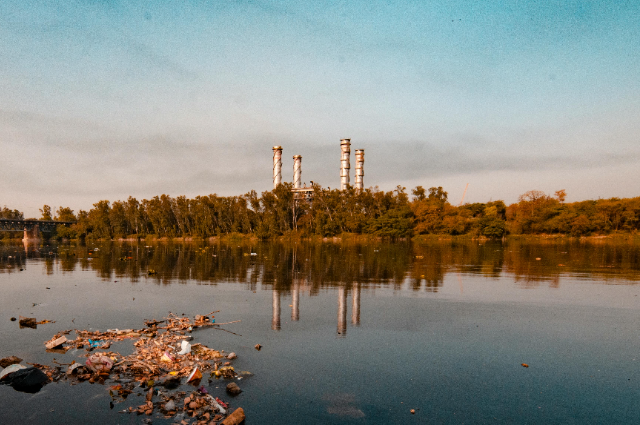
The Yamuna River especially in the Kalindi Kunj area has recently seen a disturbing rise in pollution. Thick layers of toxic foam were observed floating on the surface of the river. This incident follows similar reports which reflects a growing environmental issue that continues to worsen.
Repeated Occurrences Signal a Severe Problem
This discovery of foam is not an isolated event. The recurring appearance of toxic foam emphasises the fact that pollution levels in the Yamuna are not improving but steadily increasing. It reflects the unchecked release of harmful substances into the river that is leading to the deterioration of water quality over time. Such incidents are becoming more frequent as these are raising concerns about the long-term impact on both the environment and public health.
Voices of Concern: Pollution's Impact on Local Communities
Dinesh Kumar, who runs a non-governmental organization (NGO) focused on cleaning the Yamuna’s ghats (riverbanks) has been actively involved in addressing this issue. He regularly organizes cleanup drives on weekends to clear the riverbanks, but the worsening pollution makes this task more challenging.
Kumar emphasized the dangerous nature of the foam by explaining that, “The foam is highly toxic and harmful not just to the skin but also to the eyes.” The presence of untreated sewage in the river is a major factor contributing to the rising foam levels. This untreated wastewater has been filled with chemicals and pollutants which has caused a rapid decline in the river’s water quality by making it hazardous for anyone coming in contact with it.
Untreated Sewage: A Primary Cause of Pollution
The root cause of the toxic foam is untreated sewage being released directly into the Yamuna. As cities along the river expand and industrial activities increase, the untreated waste from factories and households is dumped into the river without proper treatment. This has caused the water to become increasingly toxic which is making it unsuitable for human or animal use. The pollutants not only threaten aquatic life but also pose severe health risks to people living near the river, especially those involved in cleaning and maintaining the ghats.
The Need for Immediate Action
The repeated appearance of toxic foam on the Yamuna River points to an urgent need for action. Local authorities must address the release of untreated sewage and take steps to improve the overall water quality. Efforts to clean the river must be intensified and stricter regulations should be enforced to prevent industries and households from dumping waste into the river. Without swift and sustained action, the pollution levels will continue to rise, further endangering both the environment and public health. The toxic foam seen in the Yamuna River serves as a stark reminder of the growing pollution crisis. Local communities, environmental groups and authorities will need to work together to tackle this pressing issue before it goes further out of control.
BJP Spokesperson Shehzad Poonawalla Criticizes Delhi Government Over Pollution
Shehzad Poonawalla, the national spokesperson for the Bharatiya Janata Party (BJP) had taken a strong stance against the Aam Aadmi Party (AAP) government during his visit to the banks of the Yamuna River at Kalindi Kunj. Poonawalla didn't hold back as he launched a harsh critique of Delhi Chief Minister Arvind Kejriwal's administration, accusing it of engaging in what he referred to as "poisonous politics." He claimed that this political strategy has led to worsening environmental conditions in the national capital, specifically affecting both air and water quality. According to Poonawalla, these deteriorating conditions pose a serious threat to the health of Delhi’s residents.
Poonawalla's Challenge to AAP Leaders
Taking his criticism further, Poonawalla directly challenged Kejriwal and other leaders from AAP to prove their confidence in the city’s water quality by taking a dip in the heavily polluted Yamuna River. The accusation highlighted the stark difference between the government’s promises and the reality on the ground, as the river's pollution levels remain a major concern.
Alarming Decline in Air Quality
As Poonawalla’s criticism drew attention to the issue, the air quality in Delhi took a turn for the worse. The city's air had reached a dangerous "very poor" category, with the Central Pollution Control Board (CPCB) recording an Air Quality Index (AQI) of 385 at 8:00 am. The rising pollution was evident in several parts of the city including Anand Vihar, Kalkaji, Nehru Place and around the Akshardham Temple, where a thick layer of fog further illustrated the severity of the air quality crisis.
Growing Concern Over Environmental Degradation
The current situation highlights the ongoing struggle to manage Delhi's environmental problems. With both air and water quality rapidly declining, citizens are facing increased health risks further emphasizing the need for urgent action. Poonawalla’s remarks shed light on the political tension surrounding the issue as opposing parties continue to point fingers while the environmental crisis deepens.
'Poor' and 'Very Poor' AQI: Long-Term Exposure Risks
Air quality levels in the 'Poor' and 'Very Poor' categories, while not as immediately threatening as 'Severe' levels, pose their risks, especially with prolonged exposure. These categories can cause significant respiratory discomfort that will lead to issues like coughing, shortness of breath and in some cases then the onset of respiratory illnesses. Over time, continuous exposure to such polluted air can result in lasting damage to lung function and overall health.
The Need for Awareness and Caution
The warnings from the CPCB emphasize the need for both public awareness and caution, especially during periods of poor air quality. Protecting vulnerable populations such as those with existing health issues becomes critical as pollution levels rise. Additionally, even those in good health should be mindful of the dangers posed by exposure to poor air quality, particularly if these conditions persist for extended periods.
. . .
References:
